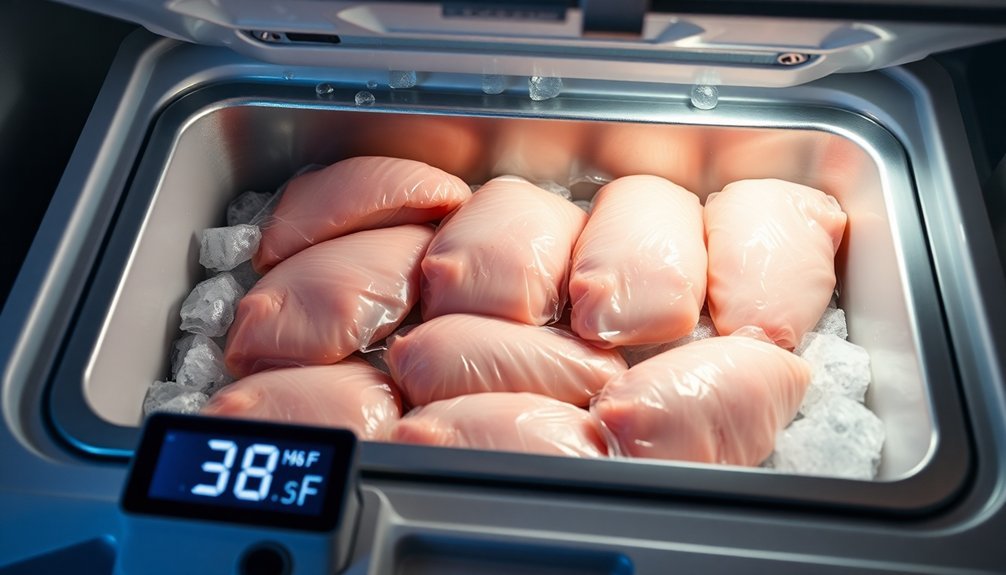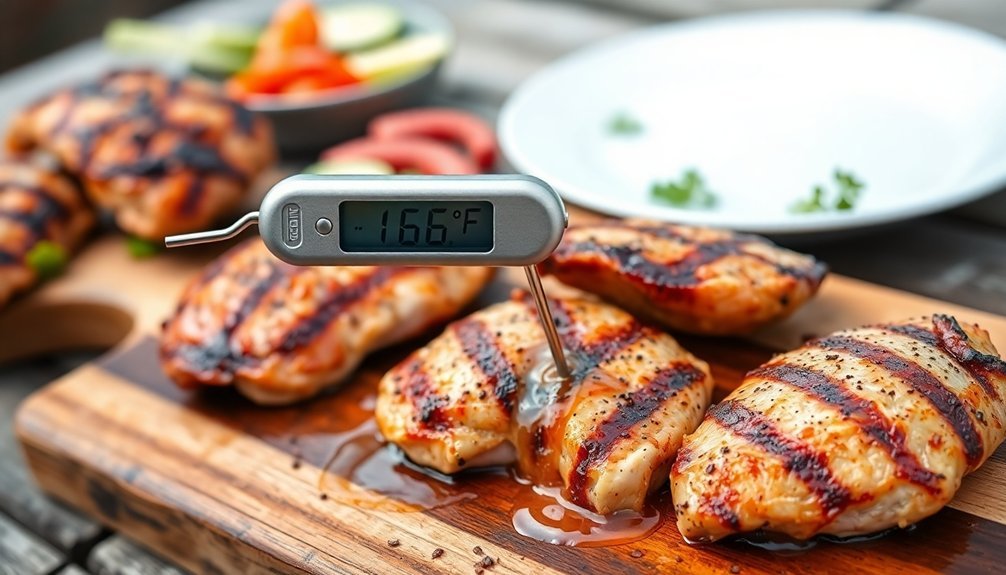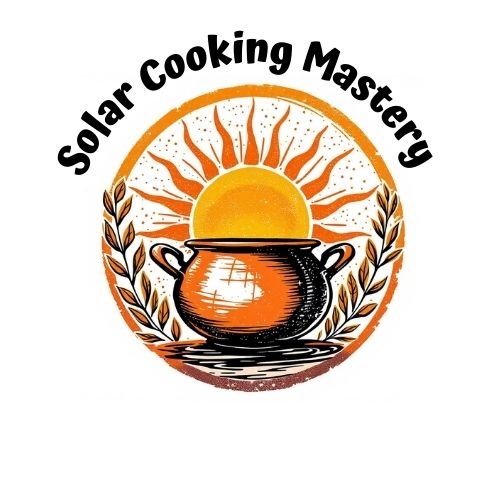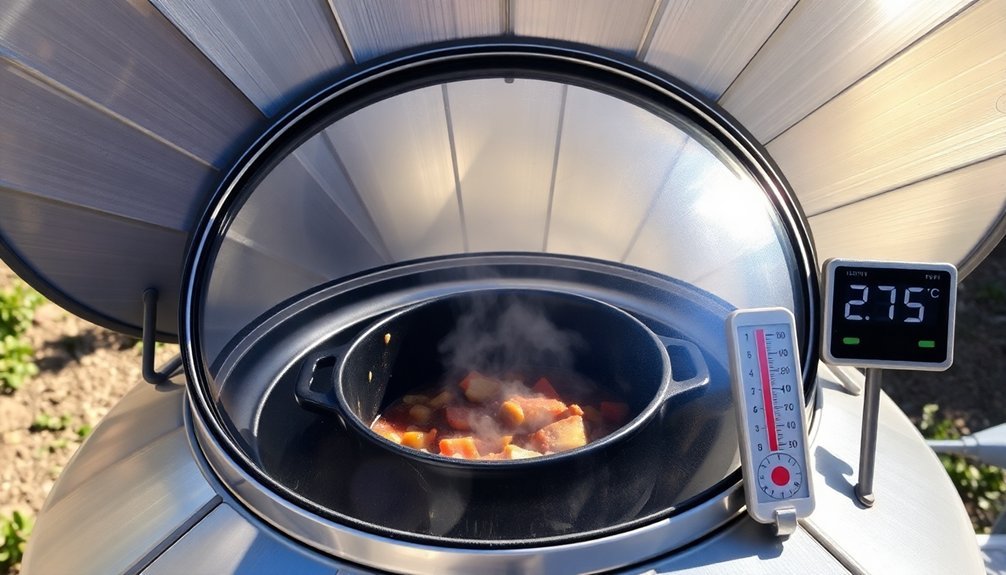Keep your outdoor chicken adventures safe by following these essential tips: Pack raw chicken in leak-proof containers at the bottom of a pre-chilled cooler below 40°F. Use separate utensils and cutting boards for raw and cooked meat. Wash your hands thoroughly or use sanitizer before and after handling chicken. Never thaw meat on the counter – use a cooler with ice instead. Cook chicken to 165°F, checking with a food thermometer in the thickest part. Store leftovers within one hour if it's over 90°F outside. Don't cross-contaminate serving platters or utensils. Pack plenty of ice and monitor cooler temperatures regularly. These fundamentals of food safety will launch you into mastering outdoor chicken preparation.
Smart Storage During Transport

Proper transport of raw chicken requires careful planning and the right equipment to maintain food safety.
You'll need an insulated hard-sided cooler with plenty of ice or gel packs to keep your chicken at a safe temperature throughout the journey.
Pack your raw chicken in moisture-proof containers or bags to prevent juices from leaking. If you're using a single cooler for multiple items, always place the chicken at the bottom to avoid cross-contamination with ready-to-eat foods.
When temperatures exceed 90°F, you must get your chicken into cold storage within 1-hour of transport.
It's best to use a separate cooler just for raw meat if possible.
Fill any empty space in your cooler with ice and keep it in a shaded spot during transport.
Don't forget to label your chicken packages with storage dates and sanitize all surfaces that come in contact with the raw meat.
Temperature Control While Outdoors
When you're transporting raw chicken outdoors, pack it in a well-insulated cooler with plenty of ice or frozen gel packs to maintain temperatures below 40°F (4°C).
You'll need to monitor the cooler's temperature regularly using a refrigerator thermometer and add ice as needed, especially during hot weather.
Raw chicken shouldn't stay above 40°F for more than 2 hours, or 1 hour if outdoor temperatures exceed 90°F (32°C).
For safe consumption, remember to cook chicken until it reaches an internal temperature of at least 165°F, as recommended by food safety guidelines.
Ice-Packed Cooler Management
Maintaining safe temperatures for raw chicken during outdoor activities requires careful cooler management and strategic packing techniques.
You'll need to pack your cooler straight from the refrigerator and use plenty of ice or frozen gel packs to keep the temperature at 40°F or below. For longer outings, consider using two separate coolers – one for immediate use and another for later needs. The Outdoor Revival™ Large Ice Pack provides high-performance cooling power that helps maintain consistent safe temperatures for hours.
- Pack raw chicken at the bottom of the cooler in watertight containers to prevent cross-contamination.
- Fill empty spaces with extra ice to maintain consistent temperature.
- Use a separate cooler for beverages to minimize lid opening on the food cooler.
- Monitor the temperature with an appliance thermometer to guarantee food safety.
For additional insulation when outdoors, you can partially bury your cooler in sand, cover it with blankets, and keep it in the shade.
Safe Temperature Time Limits
The critical window for temperature control of raw chicken outdoors requires strict adherence to time limits and safety thresholds.
You'll need to maintain raw chicken at or below 40°F until you're ready to cook it, and don't let it sit out for more than 2 hours at room temperature.
When cooking, ascertain the internal temperature reaches 165°F, checking with a thermometer away from the bone.
If you're using precise cooking methods, you can safely cook chicken at lower temperatures with specific holding times. For instance, holding at 157°F for 31 seconds will achieve safe results.
Remember that larger cuts will experience more carryover cooking than smaller pieces.
Once cooked, serve the chicken promptly or keep it above 140°F if you're planning to serve it later.
Clean Hands, Safe Food

Proper hand hygiene stands at the forefront of raw chicken safety, since your hands can spread harmful bacteria throughout your kitchen.
You'll need to wash with warm, soapy water for at least 20 seconds before and after handling raw chicken. If you're cooking outdoors where water isn't readily available, bring a jug of warm water with soap or use antibacterial wipes as an alternative.
- Scrub thoroughly under fingernails, where bacteria often hide
- Time your washing by singing the alphabet song
- Wash again after touching raw eggs, meat, or using the bathroom
- Keep wet wipes in baggies for outdoor cooking sessions
Remember that clean hands are your primary defense against foodborne illness, working alongside other essential practices like proper temperature control and preventing cross-contamination.
Prevent Cross-Contamination at Camp
When camping with raw chicken, you'll need to pack food items in completely separate containers to prevent cross-contamination with ready-to-eat foods.
Keep your raw chicken sealed in leak-proof containers or zip-top bags at the bottom of a dedicated cooler, away from other ingredients.
Even if running water isn't available at your campsite, you can maintain clean hands by using hand sanitizer, sanitizing wipes, or a portable handwashing station.
Pack Separate Food Containers
Safe camping with raw chicken requires diligent food container organization to prevent cross-contamination. Pack your raw chicken in double-layered plastic bags or sealed containers, and store them separately from other foods in your cooler.
You'll want to bring dedicated containers for raw chicken and clearly label them to avoid confusion during meal prep at your campsite.
- Use clean, sanitized containers with tight-fitting lids specifically for raw chicken
- Pack raw chicken below ready-to-eat foods in your cooler to prevent drips
- Bring extra plastic bags for double-wrapping and containing any leaks
- Label all containers and utensils that you'll use for raw chicken handling
Remember to keep your raw chicken containers away from your food prep area until you're ready to cook, and always sanitize any surface that comes in contact with raw chicken packaging.
Clean Hands Without Water
Maintaining clean hands at your campsite requires smart alternatives to running water. Keep an alcohol-based hand sanitizer with at least 60% alcohol in your toilet kit for easy access after handling raw chicken.
| Do This | Don't Do This |
|---|---|
| Wipe visible dirt/grease first | Use sanitizer on dirty hands |
| Apply sanitizer to palm | Skip between-finger coverage |
| Rub all hand surfaces | Stop before hands are dry |
| Cover fingers and nails | Miss thumb and fingertips |
| Keep sanitizer accessible | Leave sanitizer in car |
Before touching raw chicken, apply sanitizer thoroughly and let your hands dry completely. While sanitizers kill up to 99% of bacteria, they won't remove visible dirt or grease, so use a clean paper towel to wipe off any debris first. Store your sanitizer where you'll remember to use it after handling raw meat.
Proper Marinating Methods

Successful marinating of raw chicken requires careful attention to both the container choice and storage method.
You'll need to use non-reactive containers like plastic, glass, or zip-top bags, avoiding metal ones that can react with acidic marinades. Always store your marinating chicken in the refrigerator at or below 40°F, never at room temperature.
- Never reuse marinade that's touched raw chicken unless you bring it to a complete boil first
- Set aside a portion of marinade before adding chicken if you want to use it as a sauce later
- Use dedicated cutting boards and utensils for raw chicken to prevent cross-contamination
- Make certain your container is properly sealed to prevent leaks in the refrigerator
If you're planning to use the marinade as a baste or sauce, bring it to a rolling boil first to kill harmful bacteria and guarantee food safety.
Safe Thawing Techniques
When thawing raw chicken properly, you'll need to choose between three safe methods: refrigeration, cold water submersion, or microwave defrosting. Each method requires specific safety precautions to prevent bacterial growth and cross-contamination.
| Method | Key Requirements |
|---|---|
| Refrigerator | Place in sealed container on bottom shelf; allow 24 hours |
| Cold Water | Use leakproof bag; change water every 30 minutes |
| Microwave | Cook immediately after thawing; no refreezing |
| Avoid | Counter thawing; hot water; rinsing raw chicken |
| Time Frame | Fridge: 1-2 days; Cold water: 2-3 hours; Microwave: minutes |
You'll want to plan ahead if using the refrigerator method, as it takes a full day but offers the most flexibility. For quicker results, use the cold water method, changing water every half hour. Choose microwave thawing only when you're ready to cook immediately.
Using Food Thermometers Correctly

Proper thermometer use stands as the cornerstone of safe chicken preparation.
You'll need to verify your thermometer reads accurately by testing it in ice water (32°F) and boiling water (212°F) before use. When checking your chicken's temperature, insert the probe into the thickest part, avoiding bones and fat. Your target temperature should be 165°F to guarantee food safety.
- Clean your thermometer with hot, soapy water after each use to prevent cross-contamination
- Test the temperature in multiple spots for larger pieces of chicken
- Wait for the reading to stabilize before removing the thermometer
- Position the thermometer horizontally, not at an angle, for the most accurate reading
Cooler Management Essentials
You'll want to start your cooler preparation by pre-chilling it with ice blocks and packing raw chicken in sealed containers at the bottom to prevent contamination.
Pack your cooler strategically by filling empty spaces with ice and keeping raw meats separate from ready-to-eat foods.
Keep a thermometer in your cooler to monitor that the temperature stays at or below 40°F, and don't forget to return perishables to the cooler within an hour when it's above 90°F outside.
Ice and Packing Strategy
Managing your cooler effectively is essential for keeping raw chicken safe during transport and outdoor activities. Pre-chill your cooler with ice for at least an hour before packing, and place raw chicken in sealed, double-bagged containers at the bottom.
Use a separate cooler for beverages to minimize opening the food cooler, and keep it in a shaded area or partially buried in sand at the beach.
Key strategies for safe chicken storage:
- Transfer chicken directly from refrigerator to pre-chilled cooler
- Pack plenty of ice or gel packs, filling all empty spaces
- Double-bag raw chicken to prevent cross-contamination
- Keep the cooler in your car's air-conditioned compartment during transport
Remember to return perishables to the cooler within one hour when temperatures exceed 90°F, and never place cooked chicken on plates that previously held raw meat.
Safe Temperature Monitoring
Temperature monitoring serves as the cornerstone of safe chicken storage in coolers. You'll need to maintain temperatures below 40°F (4°C) to prevent harmful bacterial growth. Don't rely on guesswork – use a reliable thermometer to check your cooler's temperature regularly.
| Temperature Guidelines | Action Required |
|---|---|
| Below 40°F (4°C) | Safe zone – continue monitoring |
| 40-140°F (4-60°C) | Danger zone – adjust cooling immediately |
| Above 140°F (60°C) | Too hot – add ice or relocate chicken |
| Above 90°F (32°C) | Reduce safe time to 1 hour maximum |
When transporting your chicken, pack it in an insulated container with sufficient ice packs. Place the thermometer in the coolest part of your cooler, typically at the bottom near the ice. Check readings every hour, especially during hot weather or long trips, and add ice as needed to maintain safe temperatures.
Safe Serving Practices Outdoors

When enjoying outdoor gatherings, proper food handling becomes even more critical for chicken safety.
You'll need to be extra vigilant about temperature control and serving practices when cooking outdoors. Don't let raw chicken sit out for more than one hour if it's 90°F or warmer, or two hours in cooler temperatures. Always use cold sources to keep your raw chicken at safe temperatures during transport and serving.
- Pack separate, clean utensils and platters for handling cooked chicken – never reuse items that touched raw meat
- Keep raw chicken in sealed containers or double-wrapped to prevent juices from contaminating other foods
- Use a food thermometer to verify your chicken reaches 165°F internal temperature before serving
- Store leftovers in insulated coolers within two hours of cooking, or within one hour on hot days
Cleanup and Sanitizing Methods
Proper cleanup after handling raw chicken represents one of the most critical steps in preventing foodborne illness. Start by washing your hands with hot, soapy water for 20 seconds before and after handling raw poultry.
Clean all utensils, cutting boards, and work surfaces immediately with hot, soapy water. You'll need to sanitize all surfaces that have contacted raw chicken or its juices, but avoid using bleach due to its toxicity.
Use dedicated plastic cutting boards for raw chicken, as wooden boards can harbor bacteria. Don't forget to clean and sanitize your sink after food prep.
Always keep raw chicken in sealed containers to prevent juice leakage, and dispose of packaging materials right away. Remember to refrigerate any leftover cooked chicken within two hours and use it within 3-5 days.
Frequently Asked Questions
Can I Cook Chicken That Was Accidentally Left Frozen Overnight?
You can safely cook chicken that's remained frozen overnight since freezing stops bacterial growth. It's completely fine – just guarantee you thaw it properly and cook it to 165°F when you're ready to use it.
What Should I Do if Wild Animals Approach My Outdoor Cooking Area?
Stop cooking, make yourself appear large, and create noise to deter wildlife. Don't run, but slowly back away. Keep bear spray ready if available. Never feed or approach animals that enter your area.
Does Smoking Chicken Require Different Safety Precautions Than Grilling?
Yes, you'll need to be more vigilant when smoking chicken since it cooks at lower temperatures for longer periods. Always maintain 225-300°F and check that the internal temperature reaches 165°F for safe consumption.
How Can I Tell if My Camping Grill Is Clean Enough?
You'll know your camping grill is clean enough when grates are free of debris, there's no visible grease buildup, and surfaces don't feel sticky. Run your hand over cooled grates to check for residue.
Should I Pre-Cook Chicken Before Taking It Camping?
Yes, you'll want to pre-cook your chicken before camping. It's safer, saves time, and reduces contamination risks. You can store it properly and just reheat it at your campsite for convenient meals.
In Summary
You've now got all the tools you need to handle raw chicken safely during your outdoor cooking adventures. Remember to keep it cold, cook it thoroughly, and avoid cross-contamination. Don't skip the food thermometer – it's your best friend for ensuring safe temperatures. By following these safety tips, you'll make sure your outdoor meals are both delicious and food-poisoning free.





Leave a Reply